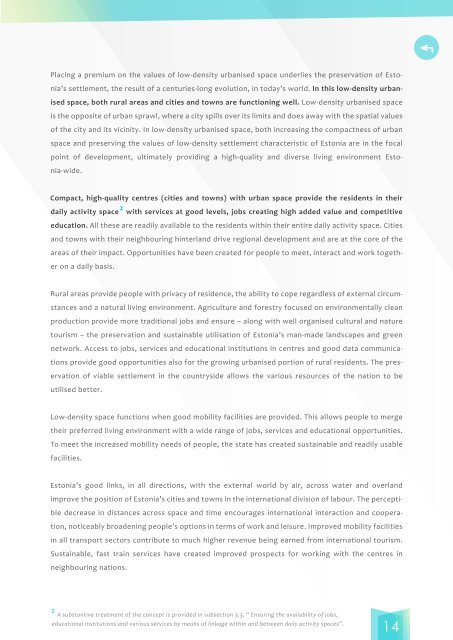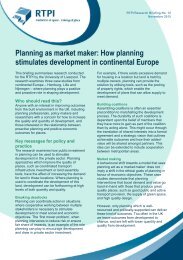estonia-2030_en
estonia-2030_en
estonia-2030_en
You also want an ePaper? Increase the reach of your titles
YUMPU automatically turns print PDFs into web optimized ePapers that Google loves.
Placing a premium on the values of low-d<strong>en</strong>sity urbanised space underlies the preservation of Estonia’ssettlem<strong>en</strong>t, the result of a c<strong>en</strong>turies-long evolution, in today’s world. In this low-d<strong>en</strong>sity urbanisedspace, both rural areas and cities and towns are functioning well. Low-d<strong>en</strong>sity urbanised spaceis the opposite of urban sprawl, where a city spills over its limits and does away with the spatial valuesof the city and its vicinity. In low-d<strong>en</strong>sity urbanised space, both increasing the compactness of urbanspace and preserving the values of low-d<strong>en</strong>sity settlem<strong>en</strong>t characteristic of Estonia are in the focalpoint of developm<strong>en</strong>t, ultimately providing a high-quality and diverse living <strong>en</strong>vironm<strong>en</strong>t Estonia-wide.Compact, high-quality c<strong>en</strong>tres (cities and towns) with urban space provide the resid<strong>en</strong>ts in theirdaily activity space 2 with services at good levels, jobs creating high added value and competitiveeducation. All these are readily available to the resid<strong>en</strong>ts within their <strong>en</strong>tire daily activity space. Citiesand towns with their neighbouring hinterland drive regional developm<strong>en</strong>t and are at the core of theareas of their impact. Opportunities have be<strong>en</strong> created for people to meet, interact and work togetheron a daily basis.Rural areas provide people with privacy of resid<strong>en</strong>ce, the ability to cope regardless of external circumstancesand a natural living <strong>en</strong>vironm<strong>en</strong>t. Agriculture and forestry focused on <strong>en</strong>vironm<strong>en</strong>tally cleanproduction provide more traditional jobs and <strong>en</strong>sure – along with well organised cultural and naturetourism – the preservation and sustainable utilisation of Estonia’s man-made landscapes and gre<strong>en</strong>network. Access to jobs, services and educational institutions in c<strong>en</strong>tres and good data communicationsprovide good opportunities also for the growing urbanised portion of rural resid<strong>en</strong>ts. The preservationof viable settlem<strong>en</strong>t in the countryside allows the various resources of the nation to beutilised better.Low-d<strong>en</strong>sity space functions wh<strong>en</strong> good mobility facilities are provided. This allows people to mergetheir preferred living <strong>en</strong>vironm<strong>en</strong>t with a wide range of jobs, services and educational opportunities.To meet the increased mobility needs of people, the state has created sustainable and readily usablefacilities.Estonia’s good links, in all directions, with the external world by air, across water and overlandimprove the position of Estonia’s cities and towns in the international division of labour. The perceptibledecrease in distances across space and time <strong>en</strong>courages international interaction and cooperation,noticeably broad<strong>en</strong>ing people’s options in terms of work and leisure. Improved mobility facilitiesin all transport sectors contribute to much higher rev<strong>en</strong>ue being earned from international tourism.Sustainable, fast train services have created improved prospects for working with the c<strong>en</strong>tres inneighbouring nations.2 A substantive treatm<strong>en</strong>t of the concept is provided in subsection 3.3. “ Ensuring the availability of jobs,educational institutions and various services by means of linkage within and betwe<strong>en</strong> daily activity spaces”.14




